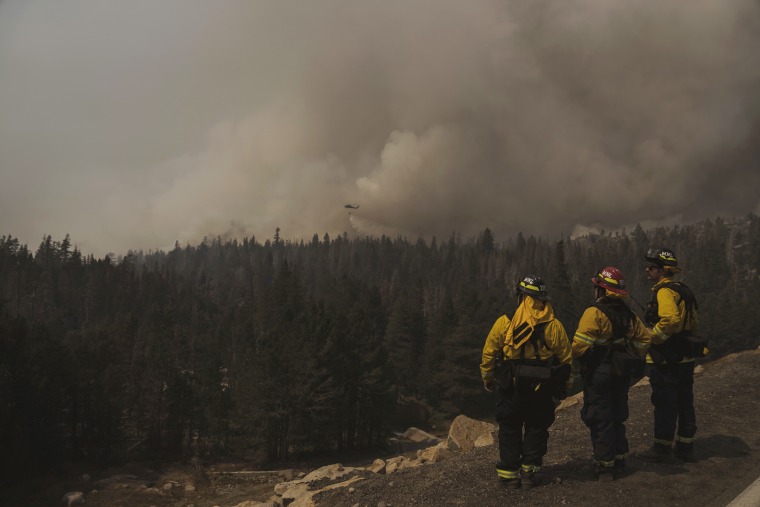A firefighters union and a chiefs association are both warning members that the protective gear firefighters wear poses a health risk because it can contain PFAS, synthetic chemicals associated with issues such as an increased risk of liver and kidney cancer.
PFAS, short for per- and polyfluoroalkyl substances, are often referred to as "forever chemicals" because they’re nearly impossible to destroy. They’re able to resist stains, grease and water, so are used to make products such as workout clothing, raincoats and firefighters' turnout gear, which is designed to block both moisture and heat.
In addition to certain cancers, PFAS have also been linked to risks of low birth weight, high cholesterol and thyroid disease.
So on Tuesday, the International Association of Fire Fighters, or IAFF, and the Metropolitan Fire Chiefs Association advised firefighters to wear turnout gear only when absolutely necessary, in order to reduce their exposure to the chemicals.
"It is essential that unnecessary carcinogens are eliminated or mitigated until we can find gear that poses no health risks to our firefighters," said Dr. Danny Whu, the union's chief medical officer.

The groups also recommended that firefighters seal the gear in a container or a bag during transport, wash their hands after touching the items and avoid bringing them into firehouse living areas.
The advisory is based on research showing that PFAS can leach out of turnout gear onto firefighters' skin and potentially enter their bloodstream. But it's hard to quantify precisely how often that happens or what health risks different exposure levels pose.
"We actually know very little about how PFAS penetrates through the skin," said Jamie DeWitt, a toxicology professor at East Carolina University.
"Presumably, it is possible and contributes to the overall health risks that firefighters face from their exposure to PFAS," she said.
Firefighters may be at particular risk of exposure to PFAS from clothing because they wear their gear for long periods of time, often while they're sweating and exposed to high heat, DeWitt said.
"When you're sweating, your pores open up, your capillaries dilate. So it's easier to absorb things that might be in materials that are on your skin," she said.
But 3M, a manufacturer of turnout gear, questioned the association of PFAS with health risks like cancer.
"Global health agencies and researchers acknowledge the limited nature of evidence indicating that PFAS cause harmful effects for specific health endpoints," the company said in a statement.
Firefighters also get exposed to PFAS through foam used on fires that are difficult to extinguish, though some fire departments have replaced the foam with PFAS-free alternatives.
DeWitt said the foam likely poses a greater health threat than turnout gear because firefighters are "drenched in it, and possibly even ingesting and inhaling some of it and absorbing it through their eyes and other mucous membranes."
The International Association of Fire Fighters said that PFAS is just one source of cancer risk that firefighters face on the job. Cancer caused 61% of line-of-duty deaths among career firefighters from January 2002 to December 2016, according to the union, due to factors such as smoke inhalation and chemical exposure. Firefighters have a 9% higher risk of being diagnosed with cancer than the overall U.S. population, according to federal data, and a 14% higher risk of dying from cancer.
The International Agency for Research on Cancer recently classified firefighting as an occupation as carcinogenic. Whu said the union is trying to eliminate exposures where it can, with the understanding that the job still carries risk.
"We can’t control most of the toxins we encounter on the fire ground, but we can and must control the unnecessary exposures to chemicals like PFAS in our personal protective equipment," he said.
Most people in the United States have been exposed to PFAS and have the chemicals in their blood, according to the Centers for Disease Control and Prevention. PFAS have been found in many consumer goods, including food packaging, carpets, cookware and personal care products.
The chemicals can lurk in drinking water. According to the Environmental Protection Agency, PFAS may pose health risks at near-zero concentrations in water, so the agency set new limits for levels of PFAS in drinking water in June.
DeWitt said that to the best of scientists' knowledge, any type of exposure to PFAS can result in negative health outcomes.
She added that for firefighters, wearing turnout gear only in emergency scenarios could reduce exposure to the chemicals, but it won't fully solve the problem.
"I wouldn't want firefighters to get the message that they shouldn't be fully protected when they need to be fully protected by that turnout gear," DeWitt said. "The solution is finding alternative moisture barriers to protect firefighters that don't contain PFAS."

